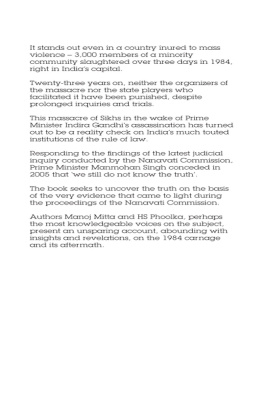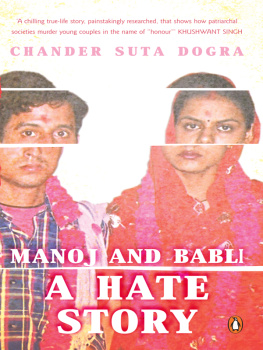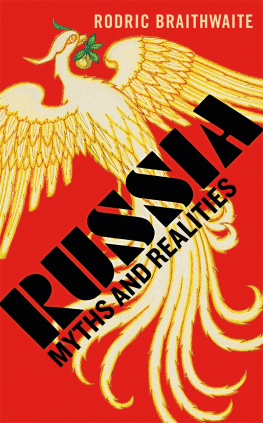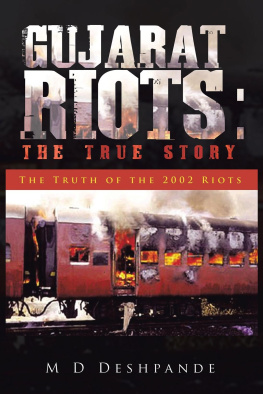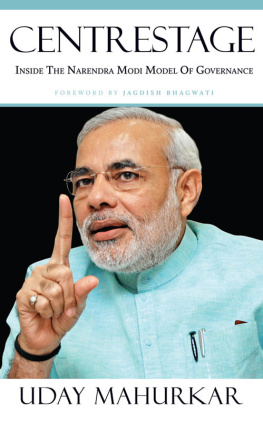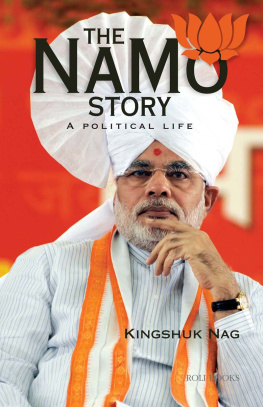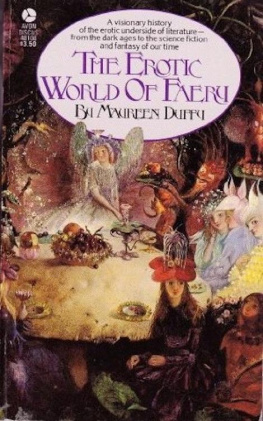Contents
First published in India in 2014 by
HarperCollins Publishers India
Copyright Manoj Mitta 2014
ISBN: 978-93-5029-187-0
Epub Edition April 2014 ISBN: 978-93-5116-031-1
2 4 6 8 10 9 7 5 3 1
Manoj Mitta asserts the moral right to be identified as the author of this work.
The views and opinions expressed in this book are the authors own and the facts are as reported by him, and the publishers are not in any way liable for the same.
All rights reserved under The Copyright Act, 1957. By payment of the required fees, you have been granted the nonexclusive, nontransferable right to access and read the text of this ebook on-screen. No part of this text may be reproduced, transmitted, downloaded, decompiled, reverse-engineered, or stored in or introduced into any information storage and retrieval system, in any form or by any means, whether electronic or mechanical, now known or hereinafter invented, without the express written permission of HarperCollins Publishers India.
Cover design: Shuka Jain
Cover photographs: Han Van Vonno/Dreamstime.com
www.harpercollins.co.in
HarperCollins Publishers
A-53, Sector 57, Noida 201301, India
77-85 Fulham Palace Road, London W6 8JB, United Kingdom
Hazelton Lanes, 55 Avenue Road, Suite 2900, Toronto, Ontario M5R 3L2
and 1995 Markham Road, Scarborough, Ontario M1B 5M8, Canada
25 Ryde Road, Pymble, Sydney, NSW 2073, Australia
31 View Road, Glenfield, Auckland 10, New Zealand
10 East 53rd Street, New York NY 10022, USA
For
my mother Indira,
who instilled in me the value of scepticism,
and
in the memory of
journalist Shoebullah Khan,
who paid with his life in 1948,
for advocating the merger of Hyderabad, my native place,
with an India he had trusted would remain pluralist
T he government of Atal Bihari Vajpayee was never able to live down a meek surrender; it handed over three terrorists to the Taliban in Afghanistan in December 1999, in exchange for a hijacked aircraft along with its crew and passengers. What is less remembered, however, is that two years later, it gave in to another extremist ideology, this time to homegrown Hindutva. On 13 March 2002, the Vajpayee government pleaded with the Supreme Court to let the Vishva Hindu Parishad (VHP) perform, two days later, a symbolic ritual near the disputed site in Ayodhya where Lord Ram was believed to have taken birth. The situation was fraught, surreal. Barely a fortnight earlier, fifty-nine Hindus had been killed as bogies of a train were set on fire at Godhra, following a communal clash at the railway station there. The frenzied ranks of the VHP had since been on the rampage in Gujarat, leading to a carnage in which over 1,000 people, mostly Muslims, had been killed.
For all that violence, the VHP leaders were showing no signs of relenting on their Ayodhya campaign, which had sparked the Godhra incident. They prevailed upon the Vajpayee government to acquiesce to their plan of marking 15 March 2002 as the launch date of the much-touted Ram temple construction. And thats why attorney general Soli Sorabjee was before the Supreme Court, batting for the VHP on behalf of the government.
The bench, headed by Chief Justice B.N. Kirpal, was, however, unwilling to trust the VHPs assurance that they would confine themselves to a symbolic puja. This was not only because the same organization was complicit in the ongoing post-Godhra violence. There was a prior reason too. The last time the court had trusted the VHPs promise to hold a symbolic ritual in Ayodhya, it had led to the demolition of the Babri Masjid, arguably the greatest blow to secularism in India since Partition. We dont want a repeat of the December 6, 1992 incident, the bench observed, seeing through the ploy of the symbolic puja.
Within hours, the VHP chief, Ashok Singhal, proclaimed to the media in Ayodhya that the Supreme Court order had actually gone in the organizations favour. The cause for his jubilation was an error in the 13 March order. Had this error not been corrected in the little time that was left, it could have helped the VHP escalate communal tension across the country.
The error lay in the description of the 67 acres of governmentacquired land that was covered by the status quo injunction. Though the acquired land encompassed over 100 revenue plots, the Supreme Court order directing status quo inadvertently referred only to two revenue plots. This gave scope to the VHP to pretend that it could still lawfully perform puja in the government-acquired land surrounding the disputed site. In my report in The Indian Express on the Supreme Court proceedings, I pointed out the error and explained how it had crept into the order. Seeing my report on the morning of 14 March, Justice Kirpal corrected the ambiguity by holding an unscheduled hearing before his bench the same day. The prompt corrective put paid to the VHPs chances of pulling off the puja the next day. Contemporaneous accounts of this politico-legal drama referred to the catalytic role played by my report. Take jurist A.G. Nooranis analysis in the Frontline magazine of 30 March 2002: Thanks entirely to Manoj Mittas mention of an inadvertent error in the description of the acquired plot, the court clarified on March 14 that the entire acquired land of 67.703 acres was covered.
The purpose of this recollection is not to blow my own trumpet. Rather, it is to convey that, as a journalist tracking the Indian legal system for almost three decades, I have always sought to expose mistakes, even if these were committed by no less an august body than the Supreme Court. The one on the acquired land in Ayodhya was a rare instance, though, of a mistake being acknowledged, and promptly at that. The exception happened because the mistake in question was, as Noorani pointed out, inadvertent. Where the mistake was deliberate, as would be the case most times, the authority concerned would tend to be in denial.
This book is about mistakes committed in the course of factfinding on the Gujarat carnage, an offshoot of the Ayodhya dispute. The material on fact-finding was gleaned not just from the reports of committees and commissions set up to probe the carnage, but also the reports of investigating agencies, and even the judgments and orders of courts. Serious as they were, a lot of these mistakes covered up political and administrative complicity in the post-Godhra violence. The distortions in the findings were thanks to the insidious manner in which issues had been framed, facts selected, evidence recorded or inferences drawn.
This is my second book on the vagaries of fact-finding in India, and this is again in relation to a carnage. The first was on the anti-Sikh violence in Delhi in 1984, the very event that is often cited as the benchmark of comparison to the 2002 violence in Gujarat. Common to both books is an unsparing look at the cover-up done under the guise of fact-finding, irrespective of whether its ultimate beneficiary was Rajiv Gandhi or Narendra Modi. Published in 2007, When a Tree Shook Delhi questioned the oft-quoted view of academic Ashutosh Varshney that the riots in Gujarat were the first full-blooded pogrom in independent India. Little wonder then that in his memoirs brought out in 2008, BJP leader L.K. Advani referred to my book in a chapter devoted to the Gujarat carnage. The scale of the killings was greater in 1984, the violence more one-sided and the cover-up more intractable. It was all the same an easier book for me because of my co-author, senior advocate H.S. Phoolka, the spearhead of the entire struggle for justice in the anti-Sikh violence. The present work has turned out to be more challenging, partly due to the absence of a Phoolka-like counterpart involved with all the rounds of fact-finding.


